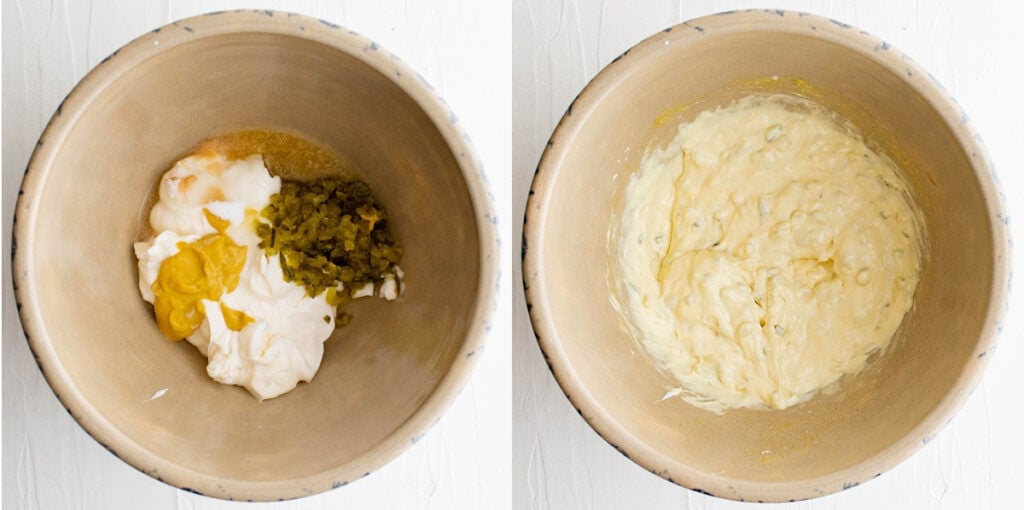This post may contain affiliate links. Please read our disclosure policy.
Southern Potato Salad is a classic recipe that’s perfect for potlucks, picnics, and BBQs. It’s creamy, tangy, and whips up in less than 30 minutes. You can even make it up to a day ahead of time.
Potato Salads are perfect for a family cookout or as a potluck dish. I promise you everyone will be asking for this Southern Potato Salad recipe!

Table of Contents
About the Recipe
This old fashioned Potato Salad recipe has chunks of potato, hard boiled eggs, and pickle relish with a creamy mayo-based dressing.
It’s the perfect side dish to serve with everything from backyard BBQ favorites like Juicy Grilled Hamburgers and Grilled Chicken Breast to picnic fare like a Club Sandwich or Fried Chicken Thighs.
Ingredients for Potato Salad

- Potatoes – read on for the best potatoes to use for my Southern potato salad recipe. I am a fan of russets or red potatoes.
- Hard Boiled Eggs – choose whichever cooking method suits your fancy – Instant Pot Hard Boiled Eggs, Air Fryer Hard Boiled Eggs, or learn the basics of How to Boil Eggs the traditional way.
- Celery + Green Onions – to add crunch and flavor. Add more veggies if you want, like shredded carrots or olives.
- Dressing – the potato salad dressing has creamy mayo, tangy mustard, vinegar, pickle relish, garlic powder, and sugar. Follow the measurements, but then give it a taste and decide if you want to adjust anything. Feel free to customize it to something you really love. You can replace the mayo with Miracle Whip, or use chopped dill pickles instead of relish.
How to Make Southern Potato Salad
- Boil the potatoes: Peel and dice your potatoes into bite sized pieces. Watch until they are just fork tender – don’t overcook or they will become mushy. Boil, drain, and set aside to dry.
- Make the dressing: While the potatoes are drying and cooling, mix the creamy dressing in a large mixing bowl. Taste and add more mustard or mayo, or maybe more pickle relish. Add the potatoes and stir to coat with the dressing, then fold in the celery, onions, eggs, and potatoes to the large bowl with the dressing and gently stir everything together.
- Cover and chill until you’re ready to serve. Sprinkle paprika on top for color.

Best Potatoes for Potato Salad
I use good old russet potatoes when I make Southern Potato Salad. I’ve also used red other potato salad recipes like my Bacon Ranch Red Potato Salad and Lemon Herb Red Potato Salad and new or yukon gold potatoes for my Grandma’s Authentic Swabia Style German Potato Salad.
I love reds and whites because you can eat the skins. You do have to peel russets but they hold their shape the best which is why I love them in homemade potato salad. Each of these will hold their shape when you boil them.

FAQs
Most food, but especially dairy based foods like mayo should not sit out longer than 2 hours. In the interest of food safety, you should refrigerate most foods within two hours.
Keep potato salad covered and refrigerated and it will last several days.
Absolutely! Feel free to make the potato salad recipe up to 24 hours in advance. This actually let the flavors blend more and it will taste even better!
Helpful Tips
- When drying your potatoes, lay them out on a flat surface and sprinkle with a little salt. This will help them dry out quicker.
- Try a fancy mustard in the dressing, like ground mustard or dijon.
- Add the eggs to the boiling water with the potatoes for one less pot to wash. Make sure to shock the eggs (not the potatoes) in cold water.
- Keep refrigerated until ready to serve, and make ahead up to 24 hours in advance.

More Potato Recipes to Love
- Roasted Lemon Potatoes
- Crispy Roasted Red Potatoes
- The BEST Loaded Baked Potato Soup
- Loaded Smashed Potatoes
- Grilled Potatoes Recipe

Southern Potato Salad Recipe
Ingredients
- 3 pounds russet potatoes about 5 medium potatoes, peeled and cut into 1-inch cubes
- 1 ¼ cups mayonnaise
- 1 tablespoon yellow mustard
- ¼ cup pickle relish
- ½ teaspoon garlic powder
- 2 teaspoons sugar
- 2 teaspoons white vinegar
- 5 hard boiled eggs diced
- 2 stalks celery diced
- 5 green onions diced
- Salt & pepper to taste
- Paprika
Instructions
- Place diced potatoes in a large pot and cover with water. Add a couple teaspoons of salt and bring the water to a boil over medium-high heat.
- Cook until potatoes are fork tender, about 10 minutes. Watch closely and do not overcook or the potatoes will become mushy. Drain and set aside.
- In a large bowl, stir together mayonnaise, mustard, pickle relish, garlic powder, sugar and vinegar.
- Add potatoes and stir to coat completely. Fold in eggs, celery and green onions. Taste and add salt and pepper as desired. If desired, top with a few sliced eggs and a sprinkle of paprika.
Notes
- Feel free to adjust any of the ingredients for the potato or the dressing.
- Keep refrigerated until ready to serve, and make ahead up to 24 hours in advance.
- Store covered in the fridge for up to 3-4 days.







This is the second time I’ve made this. It’s delicious.
Thank you Kerry!
DELICIOUS ! DELICIOUS! DELICIOUS!
Thank you Marie!